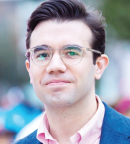An American medical student travels to rural Uganda; there, he finds most villagers walking miles to receive health care at the nearby district hospital. Upon arrival, they spend hours waiting in line. Some patients make this trip monthly.
Before entering internal medicine residency, Daniel O’Neil, MD, MPH, of the Sylvester Comprehensive Cancer Center at the University of Miami Miller School of Medicine, helped implement a program in Uganda to train community health workers to treat patients with chronic diseases right in their villages. Under this system, health workers provide patients with the same medications they would normally receive at the hospital.

Daniel O’Neil, MD, MPH
“We found that women with hypertension who could receive care near their homes ran out of medication less often and were more likely to have well-controlled blood pressure,” explained Dr. O’Neil.
Symptom-Reporting Tool
Inspired by his time in Uganda and supported by a Conquer Cancer Young Investigator Award (YIA), Dr. O’Neil continues exploring global oncology through his work to improve access to care for patients with breast cancer. To support his research, Dr. O’Neil created a tool for patients receiving chemotherapy in Johannesburg, South Africa, to report symptoms and seek advice in real time with their health providers.
The tool—a paper survey distributed prior to visiting with health-care providers—asks patients to report the severity of physical symptoms that commonly accompany chemotherapy. The survey also asks patients to rate the degree of emotional distress they are experiencing related to their cancer diagnosis, symptoms, and treatment.
Dr. O’Neil’s survey instrument helps to standardize symptom monitoring, which can reduce the chance that a patient’s symptoms are overlooked. By gathering this information prior to a visit with a health-care provider, patients receive more time dedicated to discussing side effects and improving quality of life. This low-technology approach to enhancing patient-provider communication is designed to help patients maintain their chemotherapy schedules, which should lead to less disease recurrence and longer survival.
Similar side-effect reporting technologies are proving effective in the United States and Europe, where survival rates for patients with breast cancer are higher compared to patients living in sub-Saharan African regions.
Dr. O’Neil credits donor-funded research for the opportunity to better understand the nuanced care that underserved communities need.
“Global oncology is a relatively new field. Support from the YIA meant having the time and resources to travel to South Africa, where I gained a better understanding of the local barriers to care than I ever could have over video conferencing, and where I could develop trust and rapport with my collaborators, which is foundational to this work,” explained Dr. O’Neil.
While he contributes to the field of global oncology, Dr. O’Neil believes change starts locally and must come from within each community.
“We know that few women [in this area] have routine access to trastuzumab, because the cost puts it out of reach for both individuals paying out-of-pocket and governments needing to fund their entire national health-care system,” said Dr. O’Neil. “Improving the quality of cancer care in sub-Saharan Africa will require both addressing those universal problems and developing the tools and strategies needed for individual centers to identify and solve their local quality problems.”
Improving Outcomes
After validating the symptom-reporting tool, Dr. O’Neil plans to monitor its impact on patient health-related outcomes, including chemotherapy adherence and survival.
“Just as with cancer medicines, many of the quality improvement tools needed to improve care already exist but must be adapted to work effectively in a new environment,” explained Dr. O’Neil. “The key to improving outcomes is making it easier for patients to access treatments that already exist.”
© 2020. American Society of Clinical Oncology. All rights reserved.

